Officials expect NATO’s new chief Rutte to maintain Stoltenberg’s priorities
NATO officials expect Rutte to focus on rallying support for Ukraine, ensuring unity within the alliance, addressing Eastern European allies' demands for increased security.


Mark Rutte, former Dutch prime minister, is set to take over as NATO’s Secretary General on 1 October, facing a complex set of challenges that will test his leadership and coalition-building skills.
Reuters says Rutte’s primary tasks will include rallying Western support for Ukraine, reassuring Eastern European allies concerned about Russian aggression, and maintaining alliance unity amid potential political shifts in the United States, a possible return of NATO-skeptic Donald Trump as the US President. NATO officials and diplomats expect Rutte to continue the priorities set by his predecessor, Jens Stoltenberg, according to Reuters.
The incoming NATO chief’s experience as the Netherlands’ longest-serving prime minister is seen as an asset in his new role. Kajsa Ollongren, a former Dutch Defense Minister who served under Rutte, told Reuters,
“The fact that he is so experienced in finding ways to go forward, compromises, persuading people, convincing people, connecting to people – I think that will come in very, very useful.”
Rutte’s leadership style is described as extremely driven and hands-on, which may present a change for the hierarchical structure of NATO. Ollongren noted,
“He will never think: Oh, well, I can leave this until tomorrow.”
One of the key challenges Rutte faces is addressing the concerns of NATO’s eastern members. Peter Bator, former Slovak ambassador to NATO, stated,
“One test for him will be: What is NATO’s ambition vis-a-vis the eastern flank and especially the strengthening of the eastern flank?”
Eastern European countries are pushing for more troops and weapons, particularly air defense systems, which will require persuading western members to relocate more of their assets eastward.
Another critical issue is defense spending. NATO estimates that 23 of its 32 members will meet the goal of spending 2% of GDP on defense this year. However, many NATO officials argue that spending may need to increase further, possibly to 2.5% of GDP or more, to support additional troops and arms for the alliance’s revamped defense plans.
Related:
- White House welcomes Dutch PM Rutte as next NATO chief
- Erdogan: US and NATO members do not want Ukraine to join the Alliance
- Stoltenberg urges increased weapons support for Ukraine in NATO farewell speech
- Ukraine joins NATO’s counter-drone drills for first time
- Dutch PM offers buying Patriot systems for Ukraine from reluctant countries
- Stoltenberg: Each NATO ally to decide on Ukraine’s use of missiles in Russia
- Stoltenberg admits NATO’s pre-war support for Ukraine fell short



